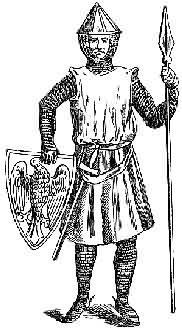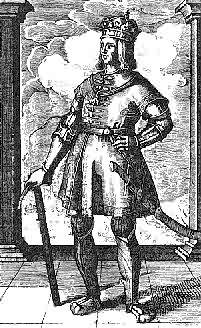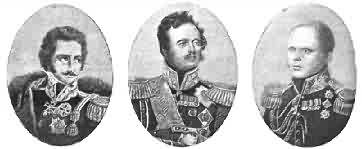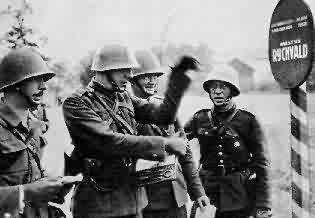
MARCH OF THE TITANS - A HISTORY OF THE WHITE RACE
CHAPTER 33 : CONTINUAL CONQUEST - THE BALTIC STATES
Part i - The Teutonic Knights and Poland
The history of the White Baltic states - Estonia, Latvia, Lithuania, Poland and Prussia - was made bizarre by the dramatic and unexpected appearance of a Christian religious order known as the Teutonic Knights, which had been founded in Palestine during the Crusades against Islam.
The spread of the Teutonic Knights into north eastern Europe from Palestine alone make this region worthy of study as a fascinating insight into the spread of Christianity. Even if this were not the case, the Baltic states have also produced peoples and disputes which shaped European history right into the 20th Century - and, given the high degree of racial homogeneity still existing in that region, might yet play an even more significant role in future.
THE TEUTONIC KNIGHTS OF SAINT MARY'S HOSPITAL AT JERUSALEM
The Teutonic Knights were a German religious military order founded during the Crusades in 1190. Their deeds on behalf of Christendom had become legendary, and they were put to work by order of the church against White pagans in eastern and north eastern Europe. Their murderous activities on behalf of Christianity - where they killed many thousands of White pagans who refused to convert to Christianity - has already been reviewed in the chapter dealing with Christianity itself.
In 1210 the Knights were invited to Hungary to help convert the pagan Slavic tribes to Christianity. In 1226, the Holy Roman Emperor granted the Teutonic Knights control over what was then Prussia (today northern Poland) to rule as a fiefdom on condition that they convert all the locals to Christianity.
The Teutonic Knights ensured that Christianized Germans settled in the Prussia: this served a double purpose - not only could the new arrivals police the new converts, but also the Teutonic Knights realized very clearly that the easiest way to change the nature of a society was to change its inhabitants. While the importation of large numbers of Christian Germans did not change the racial composition of Prussia, it changed the cultural make-up considerably.

A Polish warrior of the 13th Century, reproduced from a Medieval manuscript. Soldiers such as this fought wars against the White Christian Teutonic Knights, and erratic Mongol invasions during this time period.
WAR AGAINST THE KNIGHTS - DESTRUCTION AT THE BATTLE OF TANNENBERG - 1410 AD
As a result of their tactics, the Knights were never popular in the region - even once the locals had all been converted to Christianity. In 1409, the King of Poland invited all enemies of the Teutonic Knights to participate in a campaign against the order - a call which led the major defeat for the Knights at the Battle of Tannenberg in 1410. By 1591 the last Knights had been expelled from the Baltic States.
REVIVAL IN SOUTHERN GERMANY
Despite their collapse in the north, the order was re-established in southern Germany and Austria, where it took part in the Battle of Vienna against the invading Nonwhite Islamic Turks in 1683. This was to be the Teutonic Knight's last war - by 1697, recruits had dried up and the last remnants were abolished by Napoleon Bonaparte in 1809.
ANCIENT POLAND - LAND OF THE POLANIE
The region now known as Poland was one of the areas settled by the easternmost branch of the original Indo-European invaders of Europe, the Slavs, the last of whom entered the territory more or less simultaneously with the fall of the Roman Empire in the west - that is, during the 3rd and 4th centuries AD.
The very name Poland is derived from the largest of these Slavic tribes, the Polanie. These Slavic tribes, like their neighbors in Eastern Europe, clung longest to the original Indo-European religions and beliefs, being amongst the last to fall prey to the murderous evangelism of the early Christians.
Southern Poland also fell prey to the ravages of Atilla the Hun, although no lasting racial imprint upon the population was left by the Asiatic warlord's passing.
THE FIRST KINGDOM UNDER BOLESLAW
Around 840 AD, the first large grouping of Slavic tribes emerged in Poland under the almost legendary king Piast. The Polish tribes were still at this stage all pagans, and it was only with the conversion of the Polish duke Mieszko, who reigned from 962 to 992, that Christianity was introduced to the Poles.
Meiszko's son, Boleslaw, who reigned from 992 to 1025, was the first Polish king to start establishing definite borders to the Polish state in formation: he engaged in a successful campaign against some neighboring Germanic tribes to the west, and slightly expanded the Polish borders as a result. Shortly afterwards Poland was however to be divided up amongst the children of the royal house, and the greater Polish state collapsed once again.
MONGOL INVASION
In 1240, the Mongol terror from the East invaded Poland, having first decimated many other Slavic tribes to the east. Fortunately for Poland, the Mongols left the next year, but large parts of the country were laid waste as a result.
Simultaneously, two new population shifts occurred. Large numbers of Prussians began to settle in Poland, moving away from internal troubles in the German states, and the first large settlement of Jews occurred in Poland, the latter moving away from growing anti-Semitism in Western Europe.
THE SECOND KINGDOM - WLADSLAW BEATS OFF GERMANS
In 1320, a new Polish king was crowned, Wladyslaw I, who achieved fame for fighting off waves of invading Germans, during the course of which Wladyslaw managed to reunite Poland.
His son, Kazimierz III, also called The Great, reigned from 1333 to 1370 and won renown for his reformation of Polish society and the founding of the Jagiellonian University in 1364. He also won the gratitude of Europe's Jewish population by actively aiding Jewish refugees from Western Europe, allowing them to settle in large numbers in Poland.

Kazimierz the Great, King of Poland from 1333 to 1370, who won renown for not only establishing a semi-peace with the Teutonic Knights, but also for his by the standards of the time, liberal policy towards Europe's Jewish population, allowing them to settle in large numbers in that country to escape increasing anti-Jewish sentiment in western Europe.
UNITY OF LITHUANIA AND POLAND - 1386 AD
Kazimierz III died heirless, and was seceded by his niece, Jadwiga, who married the Grand Duke Jagiello of the territory of Lithuania in 1386. From this time a single sovereign ruled both countries until 1569, and Christianity was introduced to the latter state, it having remained pagan right until the mid 14th Century.
THE TEUTONIC KNIGHTS
Poland and Lithuania, were however, the subject of continued invasions by the Teutonic Knights - these attacks did not stop until 1410, when a combined Polish and Lithuanian army won a great victory over the order at the Battle of Tannenberg.
This victory marked the emergence of Poland as a major power in Eastern Europe, although the Teutonic Knights were only finally defeated in 1466.
PRUSSIA ANNEXED BY POLAND
The defeat of the Teutonic Knights saw Poland acquiring the territory of Prussia, sparking off a dispute over territory which would later feature prominently in Polish history.
A long period of cultural and technological advances followed, with Polish history only being marked by a number of minor conflicts over succession to the Polish throne and the stamping out of the Protestant reformation by 1600.
After 1600, however, Poland's fortunes waned. Apart from disastrous wars with Sweden, Russia and Ukrainian Cossacks - far off distant racial cousins - Poland became embroiled in the great Nonwhite invasion of Eastern Europe when the Ottomans penetrated deep into Europe.

Vladislav III, the boy king of Hungary and Poland, Barely fifteen when he ascended to the throne in 1440. He lived a further four mere years - leading a White army against the invading Nonwhite Turks, Vladislav fell at the Battle of Varna in 1444.
POLISH ARMY SAVES VIENNA FROM THE NONWHITE INVASION
The massive contribution of the Polish army, which combined with a German army, but under the overall command of the Polish general Jan III Sobieski, to the defeat of the invading Nonwhite Turkish hordes outside the gates of Vienna in 1683, cannot be overstated - it was crucial and very possibly without the Polish intervention, Vienna would have fallen to the Turks, which would have then opened the way for the final Turkish conquest and Islamification of all of Europe.

The Polish general Jan III Sobieski, who led the Polish army at the Battle of Vienna in the year 1683 against the invading Nonwhite Turks.
RUSSIAN INVASION - 1764 AD
In the early 18th Century, Russia, seeking to advance its borders westward, began a campaign against Poland; this finally culminated in an European wide conflict known as the War of the Polish Succession, fought from 1733 to 1735, over the right to succeed to the Polish crown.
Dissatisfied with the result, Russia invaded Poland directly in 1764, and placed a favorite of Tsarina Catherine the Great, one Stanislaw II Augustus, on the Polish throne. This blatant expansion by Russia was viewed with justifiable alarm by the other powers in Europe: Prussia and Austria, fearful of a general European conflict proposed a plan for Poland to be divided up rather than become an object of conflict.
THE PARTITION OF POLAND
Shaken by a war with the Ottoman Turks, which had broken out immediately after the invasion of Poland, the Russian government agreed to the partition plan, and in 1772, a formal agreement was signed, with many Polish nobles being persuaded to accept the division of their country into units administered by Russia, Prussia and Austria, by large payments of riches and money.
Other sections of the Polish population were however not so easily bought off: growing discontent led to the Polish parliament, or Sjem, (which had not been disbanded at the time of the partition) drafted a new constitution in 1788, and then reproclaiming Poland as a hereditary monarchy.
This led to a new Russian invasion in 1792, assisted by Polish nobles excluded from the new constitutional structures. Russian armies occupied all of eastern Poland, and early the following year, the Prussians occupied the western part of Poland. These land grabs were formalized in a second partition conference held in 1793.

Racial types from Russia and Poland - leaders in the Polish/Russian wars. From left to right, Skrzynecki, Paskevitch and Constantine. General Jan Skrzynecki was in command of the main Polish army at Ostrolenka, where the Poles were defeated. Count Ivan Paskevitch commanded the Russian troops which crushed the Poles and took Warsaw with 70,000 Russian troops ranged against 40,000 Poles. Grand Duke Constantine, brother of the Tsar of Russia and governor of Warsaw, led the first evacuation of Warsaw by the Russians in 1830 - by 1831 Poland had regained its independence.
POLISH WAR OF INDEPENDENCE FAILS AND POLAND IS CARVED UP
The return of a number of Polish military men from America, where they had fought with success in the War of Independence of that country against the British, saw a renewed Polish uprising. Filled with revolutionary zeal, an army was raised and in 1794 the Poles launched their own War of Independence. Despite fighting against overwhelming odds, the Poles drove the Russians out of almost all of eastern Poland within a few months, pulling off a stunning victory at the Battle of Warsaw in 1794.
The war was however a battle of the uneven: it was only a matter of time before the Russian numerical superiority took its toll; aided by Prussian and Austrian troops, the Russians won a decisive victory at Maciejowice in late 1794. In November 1794 a Russian army entered Praga, a suburb of Warsaw, and massacred a large number of residents, sparking great resentment. The Polish War of Independence then ended within a few weeks with the surrender of the Polish army. The victorious powers once again divided Poland up between them in terms of two treaties, the last of which was signed in 1797. Poland then disappeared as a state from the map of Europe.
NAPOLEON BONAPARTE - POLES JOIN HIS ARMY
The Poles remained under foreign rule for 125 years. When Napoleon Bonaparte reached the borders of the old Polish state on his conquests against the Germans and Prussians, he declared his desire to see Poland restored to full independence - this resulted in thousands of Poles joining Napoleon's army, where they served with distinction and bravery.
In 1807, by the provisions of the Treaty of Tilsit which ended the first set of Napoleonic Wars on continental Europe, the French leader created the Duchy of Warsaw, consisting originally of the territory taken by Prussia in 1793 and 1795.
Two years later Napoleon forced Austria to cede Western Galicia to the duchy. In return the Poles gave Napoleon their whole hearted support and took an active role in his disastrous invasion of Russia in 1812.
Despite their support for Napoleon, the Poles got off lightly when the French were finally defeated. The Congress of Vienna in 1815, which oversaw the division of territory at the end of the Napoleonic wars, created the Kingdom of Poland consisting of almost the identical territory of the Napoleonic created Duchy of Warsaw, with the only significant change being the installation of the Russian Tsar as King of the Duchy. The remainder of Poland was once again distributed between Russia, Austria, and Prussia.
THE SECOND POLISH WAR OF INDEPENDENCE FAILS
In 1830, the Poles once again turned to armed revolution: by January 1831, the Russians had been driven out and Polish independence proclaimed. The Russians re-invaded and by May of that year had crushed the Polish revolt.
A policy of Russification was instituted, with the eastern territories becoming almost completely absorbed, ethnically speaking, into the Russian state.
Poland remained under foreign rule until the outbreak of the First World War in 1914.
WORLD WAR I
Living under German rule in the West, and Russian in the East, the Poles found themselves conscripted into the opposing armies of these two powers, and the ironic situation arose where Poles in German uniforms fought Poles in Russian uniforms to the death on the Eastern Front during the First World War.
The war ended however with the downfall of first the Russians and then the Germans. By November 1918, Poland was proclaimed an independent republic with Josef Pilsudski becoming head of state.
THE NEW TERRITORIES GAINED FROM GERMANY
The Treaty of Versailles, which ended the First World War, not only confirmed Polish independence, but took territory away from Germany, most notably the German city of Danzig on the Baltic coast and a stretch of land reaching up to the Baltic sea, giving Poland access to the coast and to Danzig, whilst simultaneously cutting Prussia (which became known as East Prussia) off from the rest of Germany.
Taking advantage of the confusion following the communist revolution in Russia, and the civil war in that country which dragged on until 1924, Poland invaded the Soviet Union in 1920, seizing historically Polish territory from Belarus and Ukraine before concluding a peace treaty with that emerging super power. Poland then attempted to walk a tight rope between Germany and the Soviet Union, signing non aggression pacts with both in the 1930s.
REDUCED RIGHTS FOR MINORITIES UNDER PILSUDSKI
The Polish state did not however follow a democratic internal policy. Pilsudski became an absolute dictator and allowed the rights of a number of minority groups in Poland, including Germans, Ukrainians, Belorussians and Jews to be severely infringed. The Polish government enacted specific anti-Jewish legislation, prohibiting Jews from holding certain levels of public office and other areas of influence in society.
POLAND GAINS A PART OF CZECHOSLOVAKIA
Contrary to popular myth, Poland did not fanatically resist Nazi Germany's expansionist policies - at least not as long as Poland itself was not on the agenda. In this way Poland took an active and enthusiastic part in the German created dismemberment of the Czechoslovakian state in 1938 - as part of the settlement Poland received about 1036 square kilometers (about 400 square miles) of Czech territory.

Contrary to modern propaganda, Poland did not fanatically resists Nazi expansion - as long as Poland was not on the agenda. Here are Polish soldiers, on the border with Czechoslovakia, about to launch the 1939 Polish takeover of Teschen, that part of Czechoslovakia which historically belonged to Poland. Poland was, along with Germany and Hungary, the beneficiary of the dismemberment of the Czech state as a result of the Munich conference of 1938. As long as Adolf Hitler did not dispute the Danzig corridor with Poland, the latter country was quite happy to co-operate with the German leader on most other issues.
THE DANZIG CORRIDOR
Germany then turned its demands to the German city of Danzig and the corridor separating East Prussia and Germany. The German leader, Adolf Hitler, requested that the city be returned to Germany and that the Germans be allowed to build an autobahn and railway line across the corridor to link East Prussia with Germany. Poland rejected these demands and Germany then invaded, causing the British and the French to declare war on Germany.
WORLD WAR II
The Polish Army although larger but consisting mainly of infantry and cavalry, was unprepared for modern warfare and as a result was no match for the armored German divisions. Poland was overrun in matter of weeks.
The Soviet Union simultaneously invaded Poland from the East, duplicating the German invasion from the west - this act did not bring any reaction from the French or British, in marked contrast to their declaration of war against Germany - one of the most hypocritical and meaningfully deliberate betrayals of the entire war.
POLAND OCCUPIED
The Polish population suffered greatly in the war. Hundreds of thousands were killed, directly or indirectly, with huge numbers of Polish Jews being rounded up and deported to concentration camps. The Polish also suffered under Soviet rule. Nearly 15,000 Polish soldiers who had been captured by the Soviets during their invasion of Poland were executed en masse in the Katyn forest outside the Russian town of Smolensk, where their remains were discovered by occupying Germans in 1943.


In 1943, the German army discovered a mass grave of nearly 15,000 Polish army officers in Katyn, (present day western Russia). The Polish soldiers had been taken prisoners of war by the Soviets in 1939 and then executed, with their hands bound behind their backs, with individual pistol shots in the back of the head. Above, an aerial view of the massacre scene, and alongside, a Polish poster depicting the actual executions. For many years the Soviets claimed that the Germans had been responsible for the massacre, and some low level Nazis were even charged with the crime after the war. It was only after the fall of the Soviet Union that it was definitely confirmed that Soviet Communists had been responsible.
Germany formally annexed the former German territories of the pre-World War One borders, leaving a large piece in central Poland as a Polish semi-autonomous area known as the Government General, which was under overall German administration.
The Soviet occupied part of Poland consisted of the Russian territories won by Poland in terms of the Treaty of Versailles and the 1920 war. These territories were to be later overrun by the Germans when they invaded the Soviet Union in 1941.
POST WAR POLAND
The end of the Second World War saw the utter defeat of Germany. Poland gained massive slices of German territory and set about expelling millions of ethnic Germans from these lands. More than seven million Germans were rounded up and driven across the German border, clearing vast areas of land for Polish occupation.
Of this number, approximately 2 -3 million died en route. East Prussia totally disappeared. The city of Danzig was cleared of Germans and became the Polish city of Gdansk. In the east, the Soviet Union reoccupied its lost territories once again, forcing about four million Poles to move westward, many of them taking up residence in the lands seized from the Germans.
THE COMMUNIST STATE
Although the facade of democratic government was installed in Poland after the war, the country soon became a Soviet satellite, and along with East Germany, one of the most important member states of the Warsaw Alliance, a military group created out of the Communist Eastern European nations.
ANTI-JEWISH CAMPAIGNS 1956 - 1969
In June 1956, an anti-Communist uprising took place in Poznan - it was suppressed with the loss of 53 lives. This uprising was accompanied by a violent anti-Semitic outbreak in various parts of the country, triggered by the fact that large numbers of Polish Jews participated in the Communist government apparatus.
Popular discontent erupted once again in Poland in the spring of 1968, with rioting breaking out in Warsaw, Poznan, Lublin, and Krakow, each time the uprising being not only anti-Communist, but specifically anti-Jewish, with the rioters identifying Jews with the Communist Party and government. Seeking to quell public opinion, the Polish Communist Party then turned on the Jews in its own ranks. Starting in 1968, hundreds of prominent Jews were dismissed from government, Communist Party leadership positions, university departments and from newspaper editorship posts. Many thousands of Jews left Poland after 1968, settling in America or Israel.

A Polish army tank stands in a Poznan street during the unsuccessful anti-Communist uprising of June 1956.
SOLIDARITY PARTY DEFEATS COMMUNISTS
The power of the Communist Party was eventually broken by a combination of internal revolt and the collapse of the Soviet Empire starting around 1989. Internally, worker uprisings against economic mismanagement were led by the Solidarity trade union, whose leader, Lech Walesa, would be elected president of Poland after the fall of Communism. By 1991, Poland would have its first democratic constitution and the Communist party would be voted out of power. The transfer from communism to free enterprise was however, as in all former Eastern European communist states, extremely difficult and caused economic chaos for many years.
IMMIGRATION
Unlike many countries in Western Europe, Poland did not encourage immigration from anywhere, and as such retains an extremely high degree of racial homogeneity. The only slight admixture which occurred amongst a very small number of Slavics in Poland was a comparatively tiny amount of Asiatic invaders who briefly occupied the country in the 1200s.
This influence was however extremely limited, and the overwhelming racial type found in Poland is still Nordic, or what is known as Dinaric, a combination of Nordic and Alpine sub-racial types.
Click Here for
Part ii - Lithuania, Latvia, Estonia and Prussia
or back to
or
All material (c) copyright Ostara Publications, 1999.
Re-use for commercial purposes strictly forbidden.